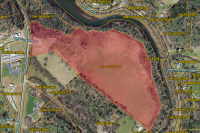Twice sold lands now part of Bryson City
This is the peculiar story of the land transactions, disputes, and incidents that led to the establishment of Bryson City and the construction of its first jail.
This town was a village named Charleston before it became Bryson City in 1889. Before that it was a tract of land known as Big Bear’s Reserve, which was itself located in the same general area as the old Cherokee village of Tuckaleechy Town (Tuckoritchie) that had been ravaged by General Grant’s British expeditionary force in 1761.
Big Bear (Yanegwa or Yonah) was a Cherokee chief who lived in the area where Bryson Branch empties into the Tuckaseigee from the north. “Big Bear’s spring” is located at the foot of the road leading over Coalchute Hill to the old Singer Plant. “Big Bear’s ford” was used into modern times. It’s located on the west side of the bridge. “Big Bear’s canoe landing” was in the immediate area.
According to James Mooney, “(Big Bear) was among the signers of the treaties of 1798 and 1805, and by the treaty of 1819 was confirmed a reservation of 640 acres as one of those living within the ceded territory who were ‘believed to be persons of industry and capable of managing their property with discretion,’ and who had made considerable improvements on the tracts reserved.” The mile-square tract apparently included most of the flat land on both sides of the river west of the mouth of Deep Creek; that is, the central portion of present Bryson City.
Big Bear was ceded his reserve in early 1819. Later that same year, he signed a deed for the land, giving it over to a white man named Darling Beck. That’s when the trouble started.
In a 1959 Asheville Citizen-Times article titled “Indian Twice Sold Land That Is Now Bryson City” (subsequently republished in Lillian Thomasson’s 1964 history of Swain County), Karl Fleming related, “History has it that Beck, who evidently was no darling, plied Big Bear with giggle-water and got his signature on a deed which exchanged the land for a promise of $50. Big Bear claimed he never got the money and about a year later, on November 25, 1820, he deeded his 640 acres of land to John B. Love in return for a wagon and a team of horses. Love immediately took possession of the land and Beck responded by filing in the courts a suit of ejectment. The court ruled that Beck was legal owner of the land and Love appealed to the State Supreme Court, which upheld the lower court decision in its December sitting in the year 1834.
Related Items
“Not satisfied with this, Love filed suit on October 13, 1835, against the widow of Beck, who had, in the meantime expired. Love’s suit was a suit in equity, whereas Beck’s suit had been an action at law in ejectment. The distinction between actions at law and suits in equity was not abolished in North Carolina until the state adopted its present constitution in 1868.
“Love attempted to show that Beck and Big Bear had rescinded their trade and that he was the rightful owner of the mile square. (The court ruled that Love was entitled to the property as his was the superior title.) In 1841, Love, who, it will be remembered, came into possession of the land for a wagon and a brace of mules, turned a tidy profit by selling the tract to John Shuler for $2,500.”
Portions of this land were subsequently owned by members of the Burns, Bryson, and Cline families before being deeded to form Charleston, the county seat of Swain County, in 1871. The village was not incorporated until 1887, two years before the name was changed to Bryson City in order to avoid confusion over mail that was mistakenly being sent to the larger city in South Carolina.
Tuckoritchie. Tuckaleechy Town. Big Bear’s Reserve. Charleston. Bryson City. All the same place. For the most part it’s been a quiet place. The jail our first citizens constructed encouraged peace and tranquility. The following description was provided by Wilbur G. Zeigler and Ben S. Grossscup in The Heart of the Alleghanies or Western North Carolina (1883).
“The old, frame court-house has its upper story used as a grand jury room, and its lower floor … holds the jail. The dark interior of the ‘cage,’ used for petty misdoers, can be seen under the front outside stairs, through a door with barred window. An apartment fitted up for the jailer is on the same floor, and, by a spiked, open slit, about six inches by two feet in dimensions, is connected with the `dungeon.’ For its peculiar purposes this dungeon is built on a most approved pattern. It is a log room within a log room, the space between the log walls filled up with rocks. It is wholly inside the frame building. Besides the opening where the jailer may occasionally peek in, is another one, similar to that described, where a few pale rays of daylight or moonlight, as the case may be, can, by struggling, filter through clapboards, two log walls, spikes, and rocks, to the gloomy interior. A pad-locked trapdoor in the floor above is the only entrance. The daily rations for ye solitary culprit, like all blessings, come from above — through the trapdoor. Here, suspected unfortunates of a desperate stripe awaiting trial, and convicted criminals, biding their day of departure for the penitentiary or gallows, are confined in dismal twilight, and in turn are raised by a summons from above, and a ladder cautiously lowered through the opening in the floor.”
George Ellison wrote the biographical introductions for the reissues of two Appalachian classics: Horace Kephart’s Our Southern Highlanders and James Mooney’s History, Myths, and Sacred Formulas of the Cherokees. In June 2005, a selection of his Back Then columns was published by The History Press in Charleston as Mountain Passages: Natural and Cultural History of Western North Carolina and the Great Smoky Mountains. Readers can contact him at P.O. Box 1262, Bryson City, N.C., 28713, or at This email address is being protected from spambots. You need JavaScript enabled to view it..









